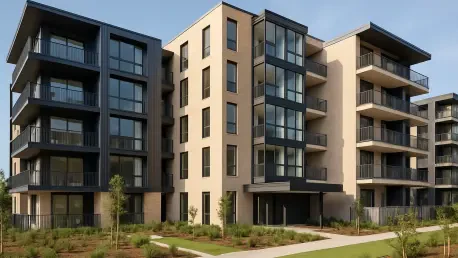In a nation grappling with persistent housing shortages, Australia’s build-to-rent (BTR) sector emerges as a beacon of potential, offering a fresh approach to addressing rental stress and housing diversity. As urban populations swell and affordability remains a pressing concern, this model—where developers build properties specifically for long-term rental rather than sale—has gained traction across major states. The surge in activity, coupled with supportive government policies, paints a promising picture, yet significant hurdles threaten to slow progress. From national trends showcasing robust pipelines to localized projects targeting specific community needs, the BTR landscape reflects both opportunity and complexity. This exploration delves into the sector’s expansion, the policies shaping its trajectory, and a noteworthy regional initiative that underscores the broader push for secure, affordable housing.
National Trends in Build-to-Rent Development
Pipeline Growth Across Key States
Australia’s BTR sector is witnessing remarkable growth, particularly in Victoria, New South Wales (NSW), and Queensland, which collectively dominate the national pipeline. Victoria leads with an impressive tally of 25,829 units either completed, under construction, or planned, while NSW follows closely with 22,025 units, and Queensland boasts 16,279. Other regions, such as the Australian Capital Territory with 2,824 units, Western Australia at 2,119, and South Australia with 1,269, contribute to a lesser extent but still reflect growing interest. According to recent industry updates, completions are anticipated to reach unprecedented levels this year, though a potential drop to around 4,000 units by next year looms due to feasibility constraints. Despite this, stabilizing factors like easing construction cost inflation and declining interest rates offer a glimmer of hope for sustained momentum in the coming years.
Challenges Threatening Sustained Expansion
While the numbers highlight an upward trajectory, the BTR sector faces notable obstacles that could impede long-term growth. Developers grapple with financial viability, as many projects remain stalled despite receiving development approvals for approximately 20,500 units nationwide. Market conditions, though improving with better access to capital, still pose risks, particularly for smaller players unable to navigate fluctuating costs. Additionally, the lack of uniform national policies creates uncertainty, with varying regulations across states complicating investment decisions. Foreign investor tax settings further deter international participation, limiting the pool of funding available for large-scale developments. Industry experts stress that overcoming these barriers is essential to unlock the full potential of BTR as a solution to housing shortages, urging stakeholders to prioritize actionable strategies for project initiation.
Policy Support and Regional Initiatives
Government Incentives Driving Progress
Government intervention has become a cornerstone of BTR advancement, with policies designed to bolster investor confidence and stimulate growth. In NSW, a permanent 50 percent land tax exemption marks a significant step forward, easing the financial burden on developers and encouraging new projects. Changes to managed investment trust legislation have also improved the investment climate, making the sector more attractive to domestic and institutional players. However, disparities in policy frameworks across the country remain a sticking point, as the absence of cohesive national guidelines can hinder broader adoption. While these supportive measures signal a commitment to addressing housing challenges, experts caution that unresolved regulatory inconsistencies and foreign investment barriers could slow the pace of expansion if not addressed with urgency.
Spotlight on Bomaderry’s Affordable Housing Project
On a regional level, a pioneering BTR project in Bomaderry, NSW, exemplifies how targeted initiatives can tackle local housing pressures. Spearheaded by the Minns Labor Government, this 60-unit development at 4 Bienda Street, constructed by a prominent builder, forms part of a $65 million state investment to enhance secure rental options in the South Coast and Northern Rivers areas. With 48 market-rate rental homes and 12 units allocated for very low to moderate-income households, the project directly addresses rental stress in the Nowra-Bomaderry region, where nearly half of households face affordability challenges. Set for completion by late this year, the development fulfills a key election promise and underscores the role of state-driven efforts in balancing market demands with social needs, as highlighted by state leaders advocating for diverse housing solutions.
Balancing Market Goals with Community Needs
The Bomaderry project also reflects a broader trend of integrating affordability into BTR frameworks, ensuring that growth does not come at the expense of vulnerable populations. In a region where over a third of residents rent, providing stable, secure housing options is critical to alleviating economic strain and fostering community resilience. State officials have emphasized the initiative’s dual focus on market viability and social impact, positioning it as a model for other areas facing similar challenges. Beyond immediate relief, such projects contribute to housing diversity, offering a mix of rental options that cater to varying income levels. As the sector evolves, the success of localized efforts like this one could inform national strategies, demonstrating how tailored investments can bridge gaps in supply while addressing the unique dynamics of regional rental markets.









